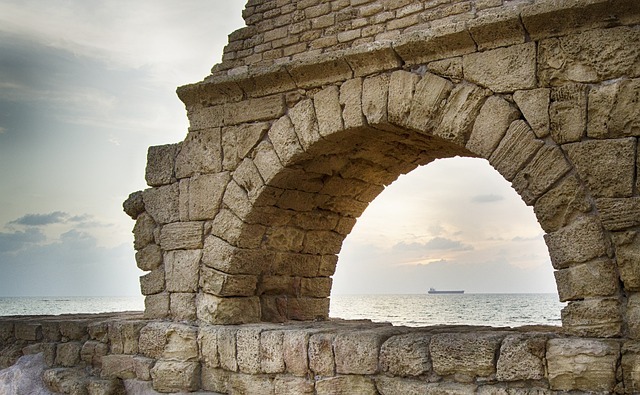CAESAREA FIELD REPORT PART 5
IV. VISITING THE EXCAVATION IN CAESAREA
IV.1. The Roman theatre
As we enter the site through an opening in the wall that surrounds the theatre, we find ourselves in a tunnel with an arched roof:
The barrel vault:
In this theatre Herod built a simple continuous vault in a typical semicircular arch with cross sections.
Already 2000 years prior to Herod the Canaanites used this kind of arch-building in Tel Dan or in Ashkelon. (Their vaults were made of mud bricks, only occasionally they used stone).
Barrel-vaults were an important part of Herod,s building. Its purpose was to build houses or other structures with more than one floor. Since wood was rare and long beams were not available, they resorted to barrel vaults.
Herod used mainly kurkar (a kind of local sandstone found along the coast of Israel) – and other lime-stones – a cheap and abundantly available stone found in the area. Since the stones were not very beautiful many structures were covered with plaster and then painted. (The plaster was also used to maintain the structural integrity of the walls).
The father of Alexander the Great built the first stone vault in Regina in northern Greece. We find barrel vaults also in Pergami in Turkey and Maresha (water caves).
The greatest example is the Temple mount in Jerusalem, where Herod used this method in order to achieve an elevated plateau on which he then built the superstructures.
The advantage of building barrel vaults is manifold: The room under the arches can be used as passage or storage-room, the area above the vault serves at the same time as base for another structure, or in the case of theatres, as ground for another sets of rows of seats for the public.
In this theatre there were two levels of barrel-vaults. This allowed spectators to look down on the stage, creating an artificial slope that carries the theatre.
This was an innovation in ancient times: the Romans were of the opinion: “We are the masters of the world – we can overcome nature if we have to!” And it is true: The Romans were the masters of urban and environmental building – comparable to today’s ideas about building and architecture.
Among the several novelties in the art of building at the time was the introduction of plastering stone that was not very beautiful in itself but cheap and easily available.
For Herod presentation and looks was all: his buildings had to look impressive and big! He did not shy from a kind of early trompe l’oeil by using cheap stone or bricks, which he then plastered and painted to look like something much more beautiful, more expensive and exclusive, e.g like marble before marble was introduced to the area. (The actual building was done by local workmen.)
Only in the times of Hadrian (1/2nd century CE) marble was imported from Marmara in Anatolia, Turkey, or from quaries in Egypt (only much later Italian marble was imported from Carrara). Hadrian renewed the theatre (a process that would be repeated again and again in later times) and converted it to other uses as well. At some time it was even flooded with water, and two boats were fighting with each other. The dentures in the stones who served for the wooden dam that kept the water within the arena are still visible.
This theatre has been heavily restored. It was excavated by Lee I. Levine and Ehud Netzer in the sixties, before a stricter code for excavations was established. Excavators felt at ease to reconstruct rather than to show the original structures, therefore only very few of the original stones are seen today.
The upper gallery was re-built on concrete – instead of trying to rebuild the former barrel vault-arches, as was the original theatre was (and still is in the case of the lower gallery).
The theatre is a semi-circular structure. Facing the sea are the two sets caveas (the sitting circles of the Roman theatre are called “kavea” =elevations on which are the seats) arranged in the way of the typical Roman theatre, with two barrel vaults above each other (today one concrete and a barrel vault), each holding about 14 rows.
Today, we can actually see the sea when sitting in the kavea. But 2000 years ago the theatre was walled in and even covered with cloths.
The fact that we know that the theatre had a roofing (the vellum/vallum) to protect the audience from sun and rain is due to the lucky finding of the architectural handbook of that time: ten scrolls from the architect Vitruvius were found, describing how to build a city and the harbor. (A fine example of how a Roman theatre looked like is seen in the film “the gladiator”).
A big part of the center is reserved for the (expensive) orchestra seats.
The stage itself was built on a podium of ca. 1m, and had also trap doors for “special effects”.
From the stage, a modern metal stairs leads downstairs to the dressing rooms. Modern performances (operas, concerts etc.) are held to this day. In Herod’s time, in this theatre mostly there were performances with actors.
We climb up the high steps to the first gallery and exit the theatre from there, which is on the same level as the entrance.
IV. 2. The model of Caesarea
We view this model, which is built on ca. 1.5m x 1.5m in a covered area, very convenient for giving explanations to groups.
Models are excellent tools to explain sites to visitors in an overall and general way.
We can see all the important places of Caesarea like the harbor, the temple, the palace, bath-houses, which are all in the center, while less important sites are further away from the center.
We see the huge temple, and how the palace is built into the sea, making an understructure mandatory (like it was mandatory for the Jerusalem Temple to have an understructure).
We see the huge harbor with its wave-breakers. (The whole outer and inner harbor sunk into the sea, but is still visible from above). We see the pagan temple, which was built above the harbor and that was dedicated to Rome and to Augustus. We are pointed out the roofed theatre, where chamber performances took place. We see the bullae which was the seat of the senate of the city.
We are pointed out the aqueducts in the far north of the area (not in the model), which brought the water from the eastern slopes through small canals to the city. (The aqueducts will be subject of a separate field trip).
IV. 3. The area between the theatre and the sea
We continue towards the city’s south-furthest walls next to the theatre.
The city walls were first built by Herod during the Roman Period (under Pontius Pilate) and in the Byzantine period, as in the later Moslem-, Crusador- and modern period the walls remained “the Wall of Herod”, even if the original structure had collapsed.
Next to the wall, towards the sea, are remains of tombs of solders. Iin the middle are tombs of crusaders.
We continue towards the sea, in front of the theatre. As pointed out before, the Roman theatre was built near the sea, the seats facing west, which is the water, but the theatre was walled in: the performances were thought to be much too important to be disturbed by nature.
Between the wall that surrounded the theatre, and the sea, we find a structure of a half circle – adjacent to the wall that blocked the view from the theatre to the sea, which was excavated. Similar structures were found also in other places. The answer to the riddle, what these structures could have served for, still has not been found.
In the space between this structure and the sea we see in the grass a lot of broken Dorian columns of plastered and painted stones or mud-bricks, giving the impression of stucco or marble.
In Byzantine times the wall in back of the theatre were used as city walls. We continue north toward Herod’s palace


